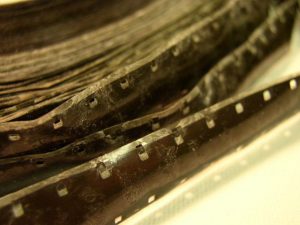Vinegar Syndrome… Is Your Microfilm Archive In A Pickle?
You are the guardians of history

Records managers and historians recognized early on that if they wanted to retain the information in newspapers, magazines, and other documents they would need to get a copy on something that was less bulky than paper and would last dramatically longer. Microfilm was the answer. One of the beliefs about microfilm was that it would last at least 500 years. However, that was not how it turned out. The first report of film breaking down came from the Government of India in the 1950’s. They stored their film in hot, humid conditions. As researchers studied the problem it became clear that all film would break down, but if it was not stored in cool and dry environment it would break down faster. “Vinegar Syndrome” (the film emits an acidy, vinegar smell…thus the name), also known as Vinegar Rot, is an indicator that the film is breaking down. The film becomes brittle and shrinks which distorts the images.
What is that smell?
Perhaps you have asked yourself that. If you go to your microfilm room right now and you smell vinegar, you already have a problem called redox. In all likelihood, when you inspect a roll of microfilm, you will notice little red dots on the film. You cannot get rid of these red dots but you can prevent it from spreading further by going through a process known as brown tone. This delays the decay but nothing can stop it. The only alternatives is to make a copy of the film on new film that does not break down or to scan the film and make a digital archive that can be viewed on PC’s and/or laptops or over the web.
Vinegar Syndrome prevalent in microfilm created before 1984
If you have any microfilm that created prior to 1984, it probably is on Acetate Film. This film tends to get brittle over time and tears very easily. The original image quality depended on the filming operator whose responsibility was to make sure the camera was meeting specifications. Compounding the issue was the film-processing technician’s attention to details. These variables included optimum levels of film developer chemicals and the water pressure was correct to wash off all the chemicals. Differences in film density could result from improper development. On lower density film, the images may be starting to fade away.
Save the information – Convert!
The only option to preserve the information and historical data on old acetate film is to convert it off the old film. Using high-speed line scan cameras along with stop motion lighting, a complete roll of microfilm can be digitized edge-to-edge, end-to-end and stored as a digital roll of film. The only viable option to preserve the history stored on acetate film is through film scanning. nextScan’s scanners and “Virtual Film” are being used to preserve our past and make information more readily available for future generations.
From small to very large archives, nextScan has the equipment to help you transition your history into the digital future. Call (208-514-4000) or contact us today to see a demonstration.
